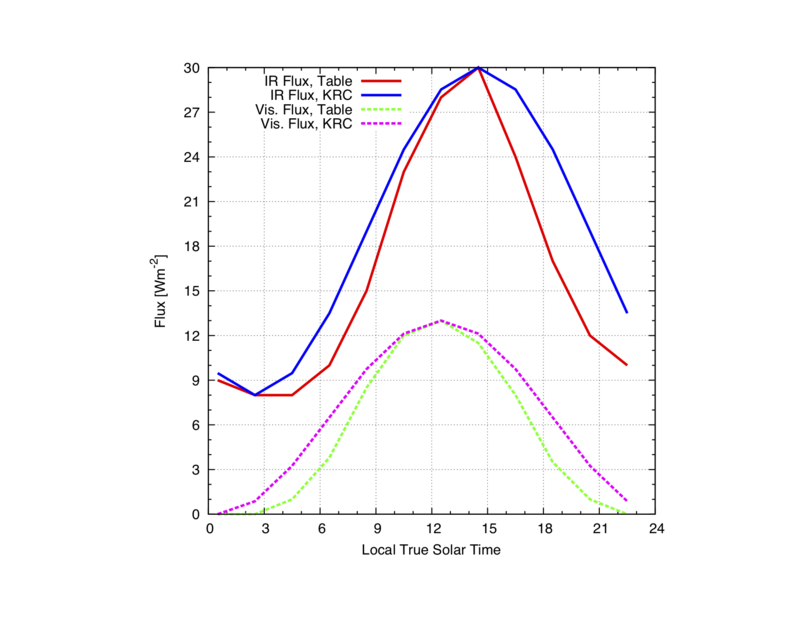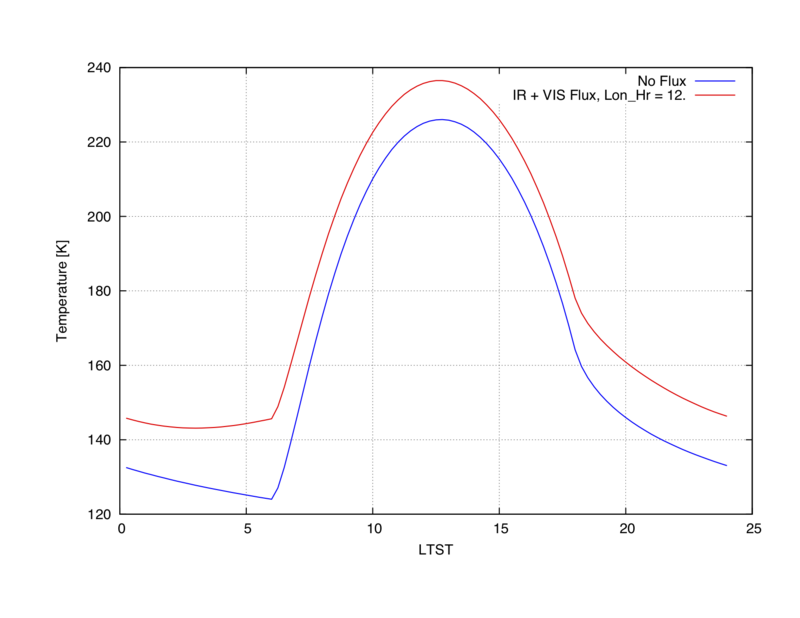Planetary Fluxes
Incoming visible and IR fluxes contributed by nearby bodies can be specified, for example Mars shine on Phobos, or Jupiter shine on Europa. Set:
PFlux = "T" Lon_Hr = [0-24]
in KRC, fluxes take the form of sin functions characterized by various nonintuitive parameters (see helplist).
The DaVinci interface generates these parameters and feed them to KRC from default parameters or user-defined values. In both cases, various assumptions and fits are performed.
While the incoming visible flux is generally straightforward to calculate, the incoming IR flux can be more complex to determine for bodies with strong diurnal temperature variations (like Mars, unlike Jupiter for example).
Fixed Diurnal Temperatures (Jupiter, Saturn, Uranus, Neptune, etc.)
This case applies to satellites revolving around gas giants, or low diurnal contrast bodies (Venus, if it had satellites) etc. The IR flux is only a function of the solid angle of the emitting body. The visible flux follows a sin function over the course of a day. Fewest assumptions used.
The simplest approach consist in using default builtin values from the KRC support files:
OUT = krc(lat=0.,INERTIA=70.,body="Europa",ALBEDO=0.55,PFlux="T",Lon_Hr=12.,LKofT="F")
But any input value can be forced:
- BT_Avg : Average Brightness Temperature [K]
- BT_Min : Min Brightness Temperature, if diurnal cycle [K]
- BT_Max : Max Brightness Temperature [K]
- Dis_AU : Distance from Sun in AU
- Geom_alb : Geometric Albedo [1]
- Mut_Period : Mutual Period [?]
- Orb_Radius : Orbiting Radius [km]
- Radius : Radius of the Orbiting body [km]
- Lon_Hr : Surface longitude relative to the sub-planet point, expressed in hours. Lon_Hr = 12. is the sub-main planet point (max fluxes), and 0. for the center longitude of the satellite hidden face. Note 18 < Lon_Hr%24 < 6 corresponds to the body's hidden face, so no fluxes are contributed in these cases.
Generally, for tidally locked bodies, the sub-planet point is located ~ at longitude = 0, so that Lon_Hr can be derived from the local longitude: Lon_Hr = (24/360 x (180 - longitude west))%24
OUT = krc(lat=0.,INERTIA=70.,body="Jupiter,Europa",bodytype="minor",ALBEDO=0.55,PFlux="T",BT_Avg=127.,BT_Min=127.,BT_Max=127.,Dis_AU=5.203,Geom_alb=0.52,Mut_Period=3.55,Orb_Radius=670900,Radius=670900,Lon_Hr=12.,LKofT="F")
Noticeable Diurnal Temperatures Cycle (Mars, Pluto, etc.)
This case applies to satellites revolving around planets experienced pronounced diurnal cycles like Phobos around Mars. The IR flux is not only a function of the solid angle of the emitting body, but also a function of the local time of the emitting body.
- 1: The user provides IR and Vis tables (File:67.1 AvgFluxes.txt).
- 2: Make IR an array with IR flux x LTST x 1
- 3: Make Vis an array with Vis flux x LTST x 1
Then the user can invoke the fluxes with PFlux = "T", Lon_Hr = Lon_Hr, IR = IR, Vis = Vis
The IR and visible fluxes are modeled by fitting a sin wave through the max and min radiance values, and KRC accepts parameters describing these two sin functions (IR, and VIS).
 External IR and visible fluxes, their best sin fits as fed to KRC by the interface, and the resulting flux error.
External IR and visible fluxes, their best sin fits as fed to KRC by the interface, and the resulting flux error.
out = krc(INERTIA=35.,lat=10.,body="Phobos",ls=Ls,PFlux="T",Lon_Hr=Lon_Hr,IR=IR,Vis=Vis)
 Modeled surface temperatures with and without the IR and Visible fluxes from Mars on Phobos
Modeled surface temperatures with and without the IR and Visible fluxes from Mars on Phobos
Davinci function krc_planetary_flux_table(IR,Vis,Lon_Hr) DaVinci function krc_planetary_flux_porb(porb,porb_Planet,Lon_Hr)
